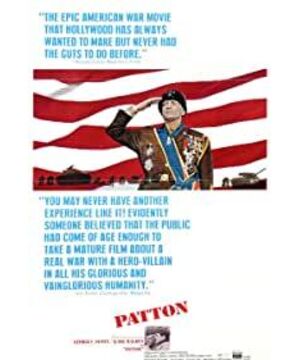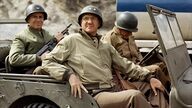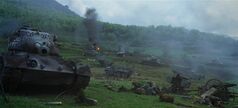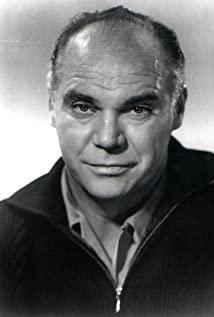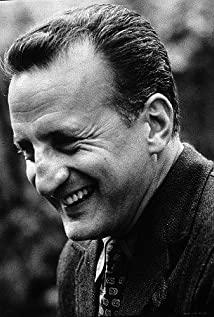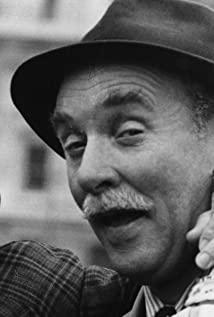The film is generally dominated by red and green tones, and the red is solemn, which is also the atmosphere created by the whole film, including a lot of looking up shots and wide-angle shots! And green is not only a symbol of soldiers, he also represents a kind of mystery, this mystery may come from Patton's psychology in the running-in of war!
At the beginning of the film, it took six minutes of footage to shoot Patton's speech, and in this part, it felt like Patton was looking at us, and it gave me the feeling that he was saying to me, yes, this is the director's intention. , he made Patton and us merge into a space, let us involuntarily freeze our thoughts in the speech!
There are two long black screens in the film, is this giving us a space to think?
Because Patton's prayers brought good weather, one said: He has a great relationship with God! In people's eyes, God is an omnipotent God, and he has a good relationship with God, which shows that Patton is also noble in people's eyes!
The director used the white horse at the end of the straight line of the mirror to shoot Patton, which is still a kind of worship, saying that he is an honest general!
The contrast between the strengths of the two dogs highlights Patton's belligerence, corresponding to the weak one in front, and in the end he took the weak dog to walk in the ruins, which gives us the feeling that Patton is always a strong man.
At the Russian-American banquet, the performers faced Barton in between, which was a kind of indignation, the director's intention to stand in Barton's thoughts!
In the videos I watched these days, I carefully observed their way of expressing sports. I found that the most important thing was the details. They captured the details of life. To make a good movie, the details of life are essential. of!
The following is a partial analysis of "General Patton" - Zhou Chuanji's speech (the speech is too incisive)
The first time I saw the American film "Barton" was shortly after the end of the Cultural Revolution, and the entire film unit in Beijing was showing this film one after another. There was indeed a sensation similar to "Titanic" at that time, but only in the film circle. I was shocked when I saw it. I haven't been in contact with American films for more than 20 years. I didn't expect them to run so far. In addition to the shock, I have a thought, am I the only one who feels this way? So an investigation was deliberately conducted. Since watching "Barton" has become a social event at that time, as long as it is a person in the film circle, it seems that they will ask if they have seen "Barton". I deliberately answered "No, how is it?" "Hey, that's awesome." "What a great trick." "That flag is so big!" I thought to myself, it's over, poisoned.
In the first fifteen seconds of "Patton", the picture shows an American flag, and the four sides of it cannot be seen. In a jargon, the audience only knows that the flag occupies the entire picture, and it is impossible to estimate how big it is. , because there is only one flag on the screen and no other reference. At the same time, we heard loud human voices, followed by a "stand at attention" password and the sound of hitting the heels of shoes. Of course we knew that the loud noise was the troops. Then a small figure emerged from the lower border in the middle of the frame, or rather, rose up. This kind of picture processing, due to the unusual proportion of the frame of reference (Barton's figure is so small) and the change of the depth relationship (Barton appears in front of the national flag, so the Stars and Stripes relegated to the background in the audience's mind), so in the audience's mind The flag here suddenly became bigger, and the three-dimensional illusion was strengthened. The effect is likely to be that the flag is so big! In this way, the filmmakers first associated the United States with the Great Britain through visual hallucinations within only fifteen seconds of the film's opening. The theme is out. This is political propaganda of the highest order. What it uses is the natural reaction caused by the audio-visual language composed of light waves and sound waves in the audience's psychology. You are anti-imperialist, but when you look at this shot, the flag still gets bigger. You can say that the United States is not great, but Patton said, I did not say that the United States is great, I only came to the stage to give a speech to my soldiers, what are you talking about. Because the audio-visual language of the film is to imitate the human's audio-visual perception experience, so if its screen image is accurate, the change like this flag will be irresistible.
Then Patton took four steps forward, stood still, saluted, and sounded the U.S. Army flag-raising bugle. The filmmakers took advantage of the flag-raising time and used more than a dozen shots to shape Patton's visual image through visual language: the majestic military uniform, including breeches, riding boots and helmets, white eyebrows, a dazzling array of medals, wedding rings, the Catholic Pope The ring presented is a whip that symbolizes military discipline, an ivory-handled pistol, the insignia of the U.S. Armored Third Army, piercing eyes, and a four-star general (note: in fact, it was only after the surrender of Germany that Congress raised him to a four-star). will). From the first minute and a half, the audience has obtained a lot of impressive information, but not a word of words.
At the end of the flag-raising ceremony, Patton said "sit down," and we heard the voices of those in the audience sitting down. Notice that for the entire opening six and a half minutes, we only see Patton and hear the movements of the soldiers listening to the speech, and no one else. Why, will be discussed below.
Patton began to speak. Its content is to brag that Americans can fight wars and never lose. I think the most philosophical thing about the military is his first sentence: "No stupid bastard wins a war by dying for his country. He wins the war by letting the other bastard die for his country. This is very incisive. One sentence. Some people win wars because more people die. There is no need to say more about lectures. We noticed that when Patton was speaking on the stage, he was walking back and forth, the camera position moved forward slowly, and the scene was in His last sentence at the end of his speech is the biggest feature in the segment, and then he turns and goes off stage, and it's over, and the music starts. It's a very nice rhythm structure. At the same time, his on and off stage, four steps forward, and Moving left and right on the stage forms a three-dimensional movement of length, width and height, showing a three-dimensional space, which is also the trick of Hollywood movies. People live in a three-dimensional space, so people are used to seeing a three-dimensional space. .
Let's further study how this paragraph was shot and why it was shot this way. (A reminder to the reader that it's not the subject matter that is shot, but how it is shot. Anyone can shoot Lei Feng's story, but different people shoot it. The results are different.)
We noticed that when Patton walked left and right on the stage in the medium and long view, he walked on the bottom line of the picture frame at most, so he did not reveal the podium. In addition, when Patton's speech was about to end, he turned around and stared at the last word of the camera lens (that is, the audience), and I am willing to lead any of you to any battlefield at any time. fighting. Be aware that one of the conventions of Hollywood movies is that the eyes of the characters on the screen cannot look at the audience. Because the characters look at the audience and their lines of sight intersect, this shot becomes the audience's subjective shot (this is the subjective shot), and this line of sight connects the world (space) on the screen with the real world where the audience lives. (Spaces) are connected so that the audience will compare the two spaces, so the illusion of that world on the screen disappears, and the Hollywood DreamWorks goes bankrupt. But the director of the film had Barton squinting at the camera for a long time. What does this do? I later asked many students in class: "Who is Patton looking at?" Most of them thought deeply from the comprehensive art theory, what he was thinking about, he stared at the sky, he looked at the soldiers, and he looked at the audience. But no one said his simplest and most direct feeling: he looked at me. And those listeners who don't understand movies at all say without thinking, "He's looking at me." correct. It's the feeling. Everyone in the audience felt Patton's eyes on himself and said, I'm willing to lead any of you to fight at any time, on any battlefield. Are you going! Patton is recruiting. Scott's Patton's personal charm is even more vividly displayed in the opening speech.
Then, when we put all the above-mentioned factors together, we can clearly see the creator's intention. The group of people implied by the sound in the space outside the painting never showed up, and the fixed camera framing was the viewpoint of the audience. The photographer took special care not to let the podium appear in the picture, and Barton mostly stepped on the bottom line of the picture frame, which is the viewpoint of an audience who listened intently. Then Patton finally looks at the camera, so that the audience clearly feels that they are occupying the space under the podium, which forces the audience to identify with the audience in the film, that the audience is listening to Patton with them.
Six and a half minutes into the film, Patton took the stage to deliver an agitation speech to the soldiers, which fully revealed the filmmaker's intention: to carry out propaganda and agitation work for young audiences. This intention is carried through throughout the prologue and is reflected in the handling of the audiovisual elements of each shot.
Now we can clearly see that it would be a big mistake to treat this scene as a speech, as many Chinese film critics do. For a film review, any film theory should be based on footage, not literary reviews or dramatic empty theories. Why do literary critics not mention the properties of films, and why theatrical reviews do not mention the time and space of films. Is it just bullying that the movie is young? Is it not allowed to study from its nature at a young age, but must study the problem from the perspective of an e-Donkey? There is no literary or dramatic basis for this film, and no literary or dramatic criticism can make the above analysis. When some critics analyze this passage, they focus on the content of Patton's speech, which is really off-topic. That is due to the lack of audio-visual reading ability. This is a very high level of militaristic psychological warfare, which makes full use of the power of the film's language, and Scott's acting skills make many audiences forget the essence of his speech.
So why does the director treat the opening of the film this way?
Let's examine the social conditions in the United States at the time of the film's release (1970).
Do viewers who have watched "Patton" feel that this is a propaganda film that promotes the military spirit of American imperialism? Some people seem to think that this film is an anti-military film. Our socialist CCTV aired "Patton" more than five times, which is incomprehensible. It is the biggest mistake caused by not knowing the audiovisual language. Don't we know that after watching the documentary we made about the United States, many young people said that they really wanted to go to that hot spot. What's the use of your fiery commentary. The picture enlisted them.
Others thought it was a patriotic film. Kawaii is concrete, we cannot educate our people with their patriotic films of Japan during WWII. Because the audio-visual image of the movie is so specific, as a result, some people may fall in love with Japan, the United States, and Patton. We can't judge a film by our own likes and dislikes, or the creator's manifesto. The evaluation of any artistic work must first comprehensively consider the era background of the work and the form of expression of the work. As far as a film is concerned, its expression must be a camera image, not a literary one. You must know that Hollywood movies have always used visual images to tell stories, and they will never violate the domestic and foreign policies of the US government. Also, Hollywood movies are a business, and catering to the audience is its top priority. It has always been based on the box office, and it has to meet the interests and social thoughts of the audience at that time. See Hollywood filmmakers (which makes sense as they call themselves filmmakers, not creators) as artists, and see their work as creators expressing their own opinions and uniqueness A work of art that is wrong, is demeaning itself. Just imagine that some people actually regard entertainment films as art films, for example, "Escape from the Tiger's Mouth" is regarded as a masterpiece, and its
low level can be imagined.
Let us now examine the American social context during the period from the late 1960s to the early 1970s. American historians refer to this period as the Dark Ages in American history, an era of disintegration. Following the Cold War and militarism, Kennedy, Martin. Luther. Kim, along with other political assassinations and Watergate, shook Americans' faith in the American system of government. The human rights movement brought black and student revolts. The black human rights movement, following the demands against racial segregation, put forward the slogan for racial segregation, that is, black power, and in 1967 it developed to the point where black people hold guns in Detroit, Chicago, and even in the capital, Washington, and other cities. There was a shootout with the police. The college students suspended classes to make a revolution and rebelled on the campus. The government dispatched the military and police to suppress them, killing four college students before and after, causing an uproar in the society. In addition, the failure of the war of aggression against Vietnam was a foregone conclusion in 1970, the first indisputable failure of the United States. American youths refused military service and burned their military service cards in public. It was at that time that boxing champion Ali was sentenced to prison for resisting military service. This is the first complete failure in the history of the American military, and even the war genre films that have always ended with the victory of the U.S. military as their big reunion went bankrupt. Facing the reality of the defeat in the Vietnam War, war genre films can no longer exist. The only film in 1968 to promote the Vietnam War "Green Beret" (GreenBeret), although still played by the American hero John. Wayne (J.Wayne) starred, but it was still a box office failure and critics, critics called it the final demise of war movies.
"Barton" came out under this special historical condition. Please don't forget that, in the same situation, the Hollywood movie "Guess Who's Coming to Dinner" that was released at the first American Film Week held in our country was also shot in this era (1967), and its content is It was in opposition to the slogan black regime put forward by the black liberation movement in the anti-government human rights movement at that time, that is to say, when the black liberation movement put forward the slogan of apartheid, this film said let's intermarry. The Chinese subtitles were played in Hong Kong, and the subtitles deliberately removed the two references to denying the black regime in the dialogue of the film. We openly insist on proletarian ideology, but we are actually propaganda for works that oppose our ideology.
At first glance, this film about the legendary heroes of World War II seems to be outside the social politics of the time, so it is more like a biographical film about a real historical figure. So people often overlook that it is a Hollywood film first, a Hollywood film shot in 1970. This kind of neglect will inevitably lead to people's wrong value judgments about the film, which is exactly what Hollywood wants to happen, just because any naked preaching will inevitably arouse the disgust of the audience, thus failing to achieve its true publicity purpose. Hollywood is very good at this. There is a famous saying in Hollywood, "Preaching? Rent an auditorium." So behind the guise of Patton, a real historical figure, there is a Patton who is saturated with the whole Hollywood value system and who relies on to achieve the Hollywood myth. This myth is hero worship.
The theme of the film is American martial arts. Although the U.S. government does not have a propaganda agency in charge of ideology to formulate propaganda policies for literary and artistic works, the Hollywood production industry, which starts from business and is therefore based on the collective cultural concept of society, has never violated the U.S. government’s internal and external policies. policy. In addition, Hollywood has a group of audiences who like watching war movies and worship individual heroism, and meeting the requirements of this group of audiences is one of its sources of revenue. Therefore, it selected the life of General Patton, a war hero in the hearts of the American people during the Anti-Fascist War, as the theme to evoke the war adventure spirit of American youth. In this way, the subject matter of Patton's biography avoids the controversial and thorny sensitive subject of the Vietnam War, but also has a strong anti-communist color. Know that, for Americans, communism is communism, no matter what differences exist among socialist countries. Not to mention that in the early 1970s, the Cold War was not over (the Cuban missile incident was not long after), and these issues were still very attractive to American audiences.
Patton is a hero in the hearts of Americans. As early as during World War I, the tank brigade he led was in St. In the battle of Mikhail, he made military exploits, and he himself was awarded the British Cross of Merit for Service. During World War II, he led the first American troops to land in North Africa. Afterwards, his Third Army was another main force with repeated achievements in the Second Battlefield, especially in Bastogne for the siege of the 101st Division and the beating of soldiers suffering from cannonball shock, which made him a worldwide leader. A legendary figure, even a middle school student in the far eastern countryside like me who experienced World War II knew about Patton. He is considered by most to be the only American commander capable of fighting a tough battle.
This mythical figure in the pen of Hollywood directors can be said to be the three prominent figures of the American style. People with strong film reading ability will find that most of the shots given to Patton are slightly elevated. The director not only put his British rival Montgomery on purpose to play an actor who is shorter than Patton, but also when the two are in the same position. In the shot, the framing intentionally causes Barton to be a head higher than Montgomery, especially in the segment where Macy enters the city. In addition, there is another handwriting that violates the law of life, that is, Patton jerks off. When Germany's Hengel swooped down to shoot, Patton opened his legs and aimed at the plane with a pistol without evasion. The impact point of the German plane's machine gun extended from a distance to the back between Patton's legs. Not being cut in half by bullets? Invulnerable, but in the continuous short shots, the audience is not easy to detect. Only aroused admiration. And after Patton beat the soldiers, Eisenhower asked him to leave the troops for inspection. He prayed in church before doing his review. The camera took a low position, Patton was kneeling in front of the altar, God was on top, Patton was below, which was in line with their religious beliefs, but this low position was set by chance, when Patton was kneeling there, the low camera The camera is level with him, but when Patton stands up, the camera rolls up and naturally creates a big shot of Patton. Before the review, use a big tilt shot? The director's POV (point of view attitude) is already very clear. Don't forget, once the camera is placed, the creator's attitude is set. Why do you put the camera here and not there, you have your thoughts, you have your attitude to the events in the shot. When he walked out of the church and walked in the courtyard of the palace, the director finally used a big overhead shot, and it was the largest overhead shot in the whole film. I think its position in the rhythm curve of the entire film structure is extremely accurate. It echoes the rhythm curve of Barton's darkest face shot (the darkest light) in the next paragraph, which is in line with the development of the plot. However, the framing of this shot is exceptionally based on a static painting composition. Very strict. There are uniform palaces on both sides, the foreground is the projection of the palace, and two tanks are parked diagonally on both sides above the screen, one on the left and one on the right. Barton's tiny figure moved slowly from the center. Very majestic. Although it is the largest overhead shot, it is not derogatory. When he walked to the platform for review, the camera on the elevator started flat, panned to the right, raised, and finally made a big overhead shot. But when Patton opened his mouth, the camera immediately jumped under the platform and shot Patton up, the sun was behind him, almost forming a halo. The director found the basis for the upside-down, because Patton's first sentence was, "You know someone asked me to come here and let you see me. Is a son of a bitch. This sentence caused laughter in the audience. Barton won, and the atmosphere of the review was completely destroyed by this sentence. The camera stayed there and kept shooting upwards until Barton's review said, "I admit that I "The method is wrong", when the two words were wrong, the camera cut to the big overhead shot from behind Patton. But after these two words, it immediately returned to the original overhead camera position. Then waited until the second Patton He added, "I hope you will accept my explanation and—(the camera is cut to a large overhead shot) to apologize. "
The camera cuts back immediately, and Patton turns around and says "disband". This is very interesting, the director's POV is too obvious. He was so reluctant to leave the camera, so unwilling to belittle Barton. Here are three prominent instances of Patton, the mythical figure.
An anachronism shot (from Baidu)
: A 1948 Packard car parked in front of a helicopter.
Anachronism: Post-war tanks are used in major North African war scenes. The German side used the M48 tank (1953) and the US military used the M47 (1952). Interestingly, the latter was named "Patton 1".
Spotting the bug: In a scene after Patton's speech, a child tries to steal a dead soldier's ring. As he leaves, some scorpions can be seen crawling onto the soldier, and the muscles in his arms/shoulders twitch in response.
Patton is looking at the battlefield with binoculars. When facing the camera, he can see the reflections of various lights/microphones and other equipment on the lens of the telescope.
Anachronism: On the European map of the command, it can be seen that the German map has been divided into East and West Germany. All national borders were demarcated after World War II.
Factual error: When Field Marshal Montgomery (Montgomery's rank at the time was a general, as shown in the film is consistent with reality, the wording is wrong here) when he is told that Patton has taken Palermo in Sicily, behind him The Union Jack was upside down.
Continuity: A German soldier is writing down casualties, marking the thousands with commas, as is the British custom. Then, the same soldier, he used the cycle on the thousand, which is like the habit of the Germans.
Spotting the mistake: A little boy can be seen grimacing and waving at the camera in every shot as locals watch the Moroccan army parade.
Found the mistake: During the First War, he was inspecting the battlefield, and the binoculars he was using were clearly labelled "Japan".
View more about Patton reviews


